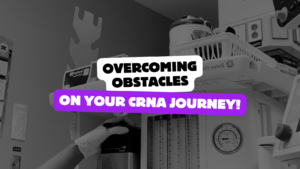Currently, there are many potential CRNA applicants looking for shadowing opportunities. Unfortunately, due to the pandemic and hospitals not allowing visitors, finding these opportunities are nearly impossible.
That said, once we get past these hardships you need to be ready to hit the ground running when you do shadow a CRNA. This could mean the difference between when you actually apply to a CRNA school and even whether or not you get accepted.
For those not familiar with me, before I gained acceptance into CRNA school I was also seeking shadowing opportunities. Of course, my background includes being a surgical technician and PACU (post operative care unit) nurse so finding a CRNA to shadow was pretty easy. But just like you, I still didn’t quite know what I should or shouldn’t do.
Here are several tips I have since learned so you have the best shadowing experience possible. But first let’s dive deeper into why you should shadow a CRNA and for how long?
Read: My CRNA Journey: Surgical Tech to CRNA- The Unbelievable
Why shadow a CRNA
Why not? When I was in CRNA school there was a student who got about 4 months into clinicals when she said “this isn’t what I thought it would be” and she withdrew from the program and never came back. Can you imagine being half way through a program and just dropping out because you never really knew the magnitude of the career? This is one of the reasons why shadowing a CRNA is so important.
Shadowing just gives you a better understanding of what a CRNA actually does. There are so many people who tell me they have never heard of a CRNA. Let alone know what we do. By shadowing a CRNA, it shows you are not only know what you are getting into but you are motivated as well.
How many hours should I shadow
Now this topic is up for debate. But I personally chose to shadow a CRNA for 40 hours total even though I worked in the operating room prior. Definitely shadow for more than a couple of hours and ideally I believe it’s important to shadow more than one CRNA. Spending time with multiple CRNAs is invaluable and allows you to see all the different ways anesthesia is provided.
Having anywhere from 30– 40 hours of shadowing experience shows program directors you are dedicated to pursuing nurse anesthesia. Shadowing a CRNA is usually required when applying to most CRNA programs. Of course, each program is different and therefore may require more of less shadowing hours.
For instance, Francis Payne Bolton School of Nursing/ Case Western Reserve University requires approximately 16 hours of shadowing. Whereas, Kaiser Permanente School of Anesthesia requires their applicants to shadow for a minimum of 8 hours.
Read: 9 Ways To Immediately Become The Strongest CRNA Applicant
19 Things to remember when you shadow a CRNA
- Dress professionally. When you shadow a CRNA, you will likely be given a pair of scrubs to change into at the hospital or facility. But prior to this you will meet the CRNA you are shadowing in the lobby. Therefore, it is important to look professional. The look you are going for is business casual. Remember, strong first impressions are everything.
- Wear good comfortable, flat, closed toe shoes. You will be walking around and on your feet most of the time.
- Be on time. Remember being early is considered on time and on time is late. And keep this way of thinking throughout your professional career. Showing up late can reflect poorly on you. Of course, things happen so just communicate this to the CRNA you are shadowing if you are running late.
- Turn off your cell phone. This is just common courtesy. And many operating rooms have a no cell phone policy anyway.
- Be nice and courteous to everyone. This is a no- brainer.
- Address all patients and health professionals as Mr., Ms. or Dr. Although they may tell you to address them by another name. Until then use these titles.
- Have an open mind, be ready and eager to learn. This will allow you to consider other perspectives and take in what is going on around you.
- Always show appreciation and never complain. There are a number of ways to show appreciation. Ultimately you just want to show you are grateful for the opportunity to shadow.
- Ask relevant questions at the appropriate time. This may seem obvious. But you would be surprised how many people ask you questions while you are interviewing the patient or drawing up medications. It will take some adjusting to figure out exactly when is the appropriate time. And to get the most out of shadowing, come ready with some questions like, What part of being a CRNA you find the most satisfying, challenging, etc.
- Listen and observe the OR atmosphere. Believe me it changes at the drop of a hat. One minute everything is going good. The next minute all crap has broken loose. Pay attention to people’s eyes and tone of voice. Is anyone talking? Quiet? Looking concerned?
- Introduce yourself to the patient and expect to talk with them. The CRNA is required to introduce you to each patient and explain that you are shadowing, so expect to talk to patients. Some patients may not be as receptive and others may actually ask you questions about yourself and career plans.
- Listen to the patients’ preoperative assessment. Observing the CRNA to patient interaction is equally as important. By observing the CRNA, you also get to see the strong communication skills CRNAs possess.
- Research the procedures or surgeries ahead of time if you can. Just knowing some basic stuff is fine. You are not required to be able to go into too much detail. But having an understanding prior will be helpful. This also shows you are motivated and knowledgeable.
- Ask yourself questions throughout the day. Things to think about. What do you not like? Is that one thing a deal breaker? Do you see yourself doing this on a daily basis?
- Bring your own shadowing log form or one from the program you plan on applying to. If you are at the point of applying to CRNA school, then you will likely have that schools shadowing form. If not, here is a shadowing log form for you. Keep up with them as they may need to be submitted with your nurse anesthesia application.
- Reflect and record your shadowing experience at end of day. Think about your shadowing experience, make note of the day. This will come in handy later down the road when you complete your CRNA school application and personal statement.
- Follow up with a thank you note. Sending a thank you note by email is acceptable, but a handwritten note is the best. Aim for sending the letter the day after your shadowing experience. This is just common courtesy honestly. This may just be the CRNA who gives you an amazing letter of recommendation for CRNA school one day.
- Understand some patients may not be comfortable with you shadowing. This will require you to leave the area or operating room for a period. Of course this is the patient’s right and no matter what just remain professional. The CRNA will likely find you someone else to shadow or find you a surgery to observe in another room.
- Keep all patient information private. You will likely be required to sign a HIPAA compliance document. In a nutshell, HIPAA stands for the Health Insurance Portability And Accountability Act and serves to keep patients’ medical information safe. Also you may have to participate in some sort of HIPAA training prior to your shadowing experience.
So, go into your day of observing a CRNA with an open and enthusiastic mind. Also remember nurse anesthesia is a small world. You either know everyone or know someone that knows someone. Therefore, making a great first impression is more important than ever. You never know the CRNA you shadow may have connections or know someone who does with the very program you plan on applying to.
Use these tips and do your homework prior to your shadowing experience to gain an accurate understanding of what all a CRNA does and if it is for you!
Have you had any luck obtaining shadowing experience during this pandemic? If so, what was the experience like?







